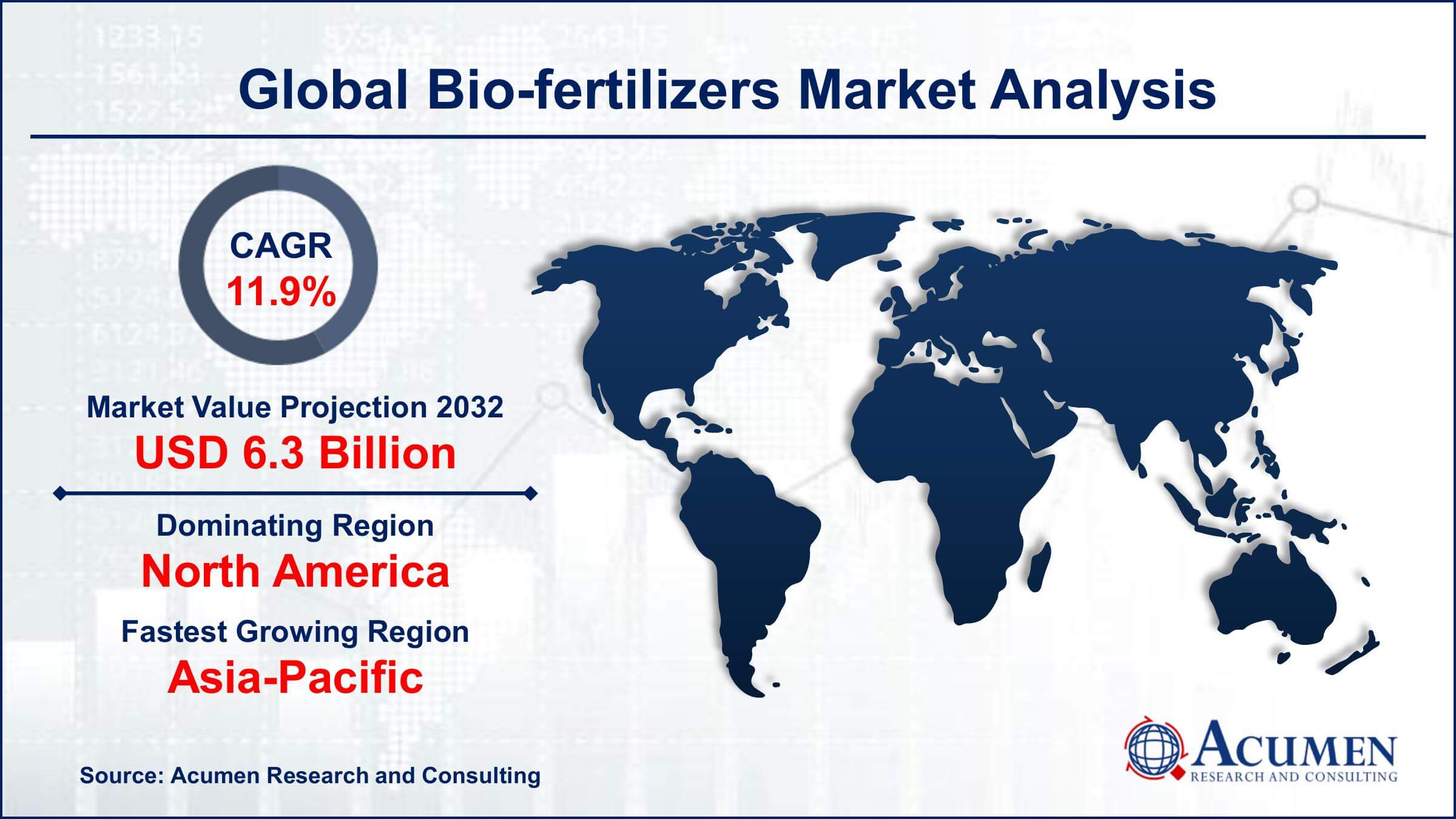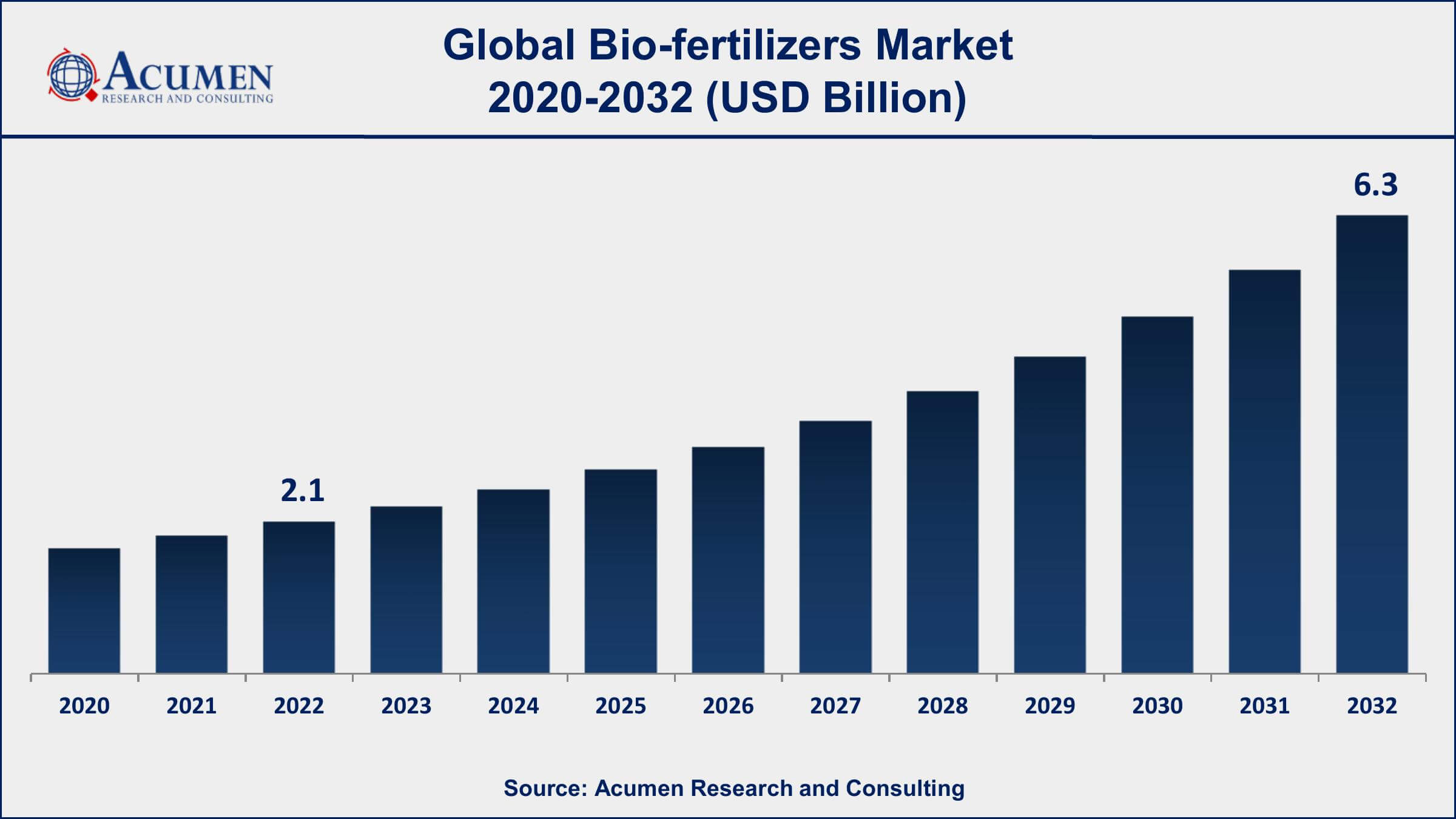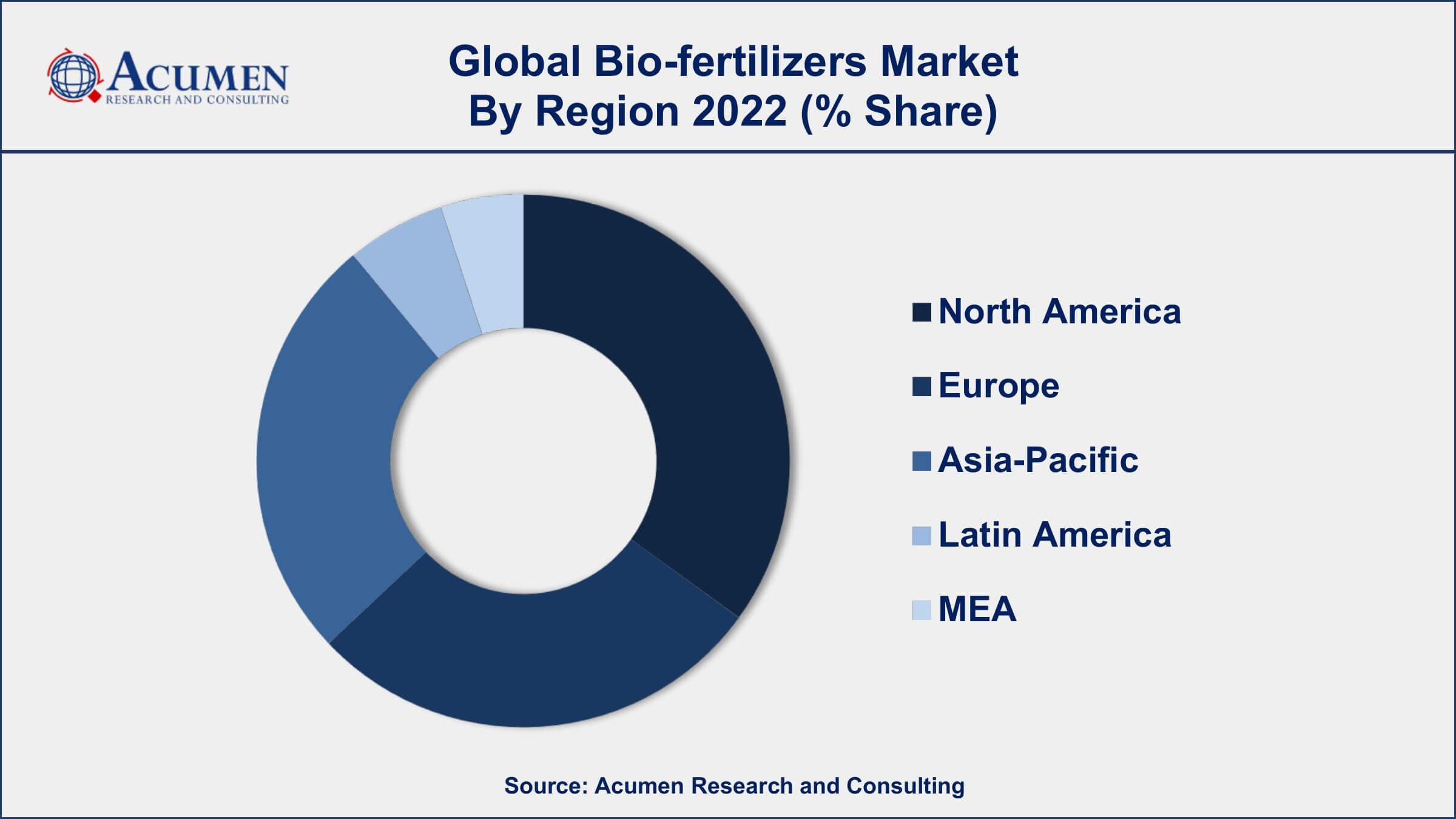April 2023
Bio-fertilizers Market Size accounted for USD 2.1 Billion in 2022 and is projected to achieve a market size of USD 6.3 Billion by 2032 growing at a CAGR of 11.9% from 2023 to 2032.
The Global Bio-fertilizers Market Size accounted for USD 2.1 Billion in 2022 and is projected to achieve a market size of USD 6.3 Billion by 2032 growing at a CAGR of 11.9% from 2023 to 2032.
Bio-fertilizers Market Highlights

Bio-fertilizers are natural microorganisms that enhance soil fertility and plant growth. They are organic in nature and have no harmful effects on the environment. These microorganisms help in nitrogen fixation, phosphorous solubilization, and plant growth promotion. Bio-fertilizers are a sustainable and eco-friendly alternative to chemical fertilizers. They are easy to use, cost-effective, and increase crop yield and quality.
The global bio-fertilizers market is experiencing significant growth due to increased awareness among farmers about the harmful effects of chemical fertilizers. The demand for organic food has also contributed to the growth of the bio-fertilizers industry. The demand for bio-fertilizers is expected to increase as governments around the world are promoting the use of eco-friendly agricultural practices. Bio-fertilizers are an important part of sustainable agriculture, and their use can help reduce the carbon footprint of farming. With the increasing demand for sustainable agriculture practices and organic food products, the bio-fertilizer market is expected to continue growing in the coming years. Moreover, the increasing demand for food due to population growth has led to an increase in the use of bio-fertilizers. The growing popularity of organic farming is also expected to drive the growth of the bio-fertilizers market in the coming years.

Global Bio-fertilizers Market Trends
Market Drivers
Market Restraints
Market Opportunities
Bio-fertilizers Market Report Coverage
| Market | Bio-fertilizers Market |
| Bio-fertilizers Market Size 2022 | USD 2.1 Billion |
| Bio-fertilizers Market Forecast 2032 | USD 6.3 Billion |
| Bio-fertilizers Market CAGR During 2023 - 2032 | 11.9% |
| Bio-fertilizers Market Analysis Period | 2020 - 2032 |
| Bio-fertilizers Market Base Year | 2022 |
| Bio-fertilizers Market Forecast Data | 2023 - 2032 |
| Segments Covered | By Type, By Microorganism, By Application, By Crop Type, And By Geography |
| Regional Scope | North America, Europe, Asia Pacific, Latin America, and Middle East & Africa |
| Key Companies Profiled | Novozymes A/S, Gujarat State Fertilizers & Chemicals Ltd., National Fertilizers Ltd., Rizobacter Argentina S.A., Lallemand Inc., Camson Biotechnologies Limited, Symborg S.L., Krishak Bharati Cooperative Limited (KRIBHCO), Rashtriya Chemicals & Fertilizers Ltd., Biomax Naturals, Madras Fertilizers Limited, and T.Stanes & Company Limited. |
| Report Coverage |
Market Trends, Drivers, Restraints, Competitive Analysis, Player Profiling, Covid-19 Analysis, Regulation Analysis |
Bio-fertilizer is a constituent that contains active microorganisms, which helps in the growth of plants by growing the number of nutrients to it. The surge in the use of bio-fertilizers is anticipated to decrease the demand for chemical pesticides and fertilizers as they impede the strength of the soil. Several growth opportunities from different sectors for bio-fertilizers are expected to offer high growth potential for this market in near future.
Increasing demand for organic food, enhancing soil fertility, and rising environmental awareness are some of the factors driving the growth of this market. However, factors such as lower adoption rates by farmers and lack of awareness are impeding the growth of this market. Formulation of favorable government policies, penetration in countries having agriculture-dominant economies, and unmet demand for fertilizers would offer growth opportunities for the bio-fertilizers market.
Bio-fertilizers Market Segmentation
The global bio-fertilizers market segmentation is based on type, microorganism, application, crop type, and geography.
Bio-fertilizers Market By Type
According to the bio-fertilizers industry analysis, the nitrogen-fixing segment accounted for the largest market share in 2022. Nitrogen is one of the most essential nutrients required for plant growth, and nitrogen-fixing bio-fertilizers help to improve soil fertility by converting atmospheric nitrogen into a form that plants can absorb. Nitrogen-fixing bio-fertilizers are usually bacteria or cyanobacteria, and they play an important role in sustainable agriculture by reducing the need for chemical fertilizers, which can have harmful effects on soil health and the environment. The growth in the nitrogen-fixing market is driven by several factors, including the increasing demand for sustainable agriculture practices, the need for higher crop yields and quality, and the growing awareness about the harmful effects of chemical fertilizers on soil health and the environment.
Bio-fertilizers Market By Microorganism
In terms of microorganisms, the rhizobium segment is expected to witness significant growth in the coming years. Rhizobium is a type of nitrogen-fixing bacteria that forms a symbiotic relationship with leguminous plants, such as beans, peas, and lentils. Rhizobium bacteria infect the roots of these plants, forming nodules where they convert atmospheric nitrogen into a form that the plant can use. Rhizobium bio-fertilizers are therefore particularly important for leguminous crops, which are an important source of protein in many parts of the world. The rhizobium segment is a significant growth area in the bio-fertilizers industry, with increasing demand for sustainable agriculture practices and the need for higher crop yields driving growth.
Bio-fertilizers Market By Application
According to the bio-fertilizers market forecast, the seed treatment segment is expected to witness significant growth in the coming years. Seed treatment is a key segment in the market, as it involves the application of bio-fertilizers to seeds before planting. This enables the bio-fertilizers to establish a symbiotic relationship with the plant from the earliest stages of growth, improving soil health, and increasing nutrient uptake. Seed treatment bio-fertilizers are usually applied in the form of seed coatings, which protect the bio-fertilizer from degradation and ensure that it is delivered directly to the plant. The growth in the seed treatment segment is driven by several factors, including the increasing demand for sustainable agriculture practices, the need for higher crop yields and quality, and the growing awareness about the harmful effects of chemical fertilizers on soil health and the environment.
Bio-fertilizers Market By Crop Type
Based on the crop type, the cereals & grains segment is expected to continue its growth trajectory in the coming years. The cereals and grains segment is a significant growth area in the market, as cereals and grains are stapled crops in many parts of the world, and increasing demand for food production has put pressure on agricultural practices to become more sustainable. Bio-fertilizers have emerged as a promising solution to improve soil health, enhance crop productivity, and reduce dependence on chemical fertilizers. The growth in the cereals and grains market is driven by several factors, including the increasing demand for food production, the need for sustainable agriculture practices, and the growing awareness about the harmful effects of chemical fertilizers on soil health and the environment.
Bio-fertilizers Market Regional Outlook
North America
Europe
Asia-Pacific
Latin America
The Middle East & Africa

Bio-fertilizers Market Regional Analysis
North America is dominating the bio-fertilizers market due to several factors, including the increasing demand for organic food, the need for sustainable agriculture practices, and the growing awareness about the harmful effects of chemical fertilizers on soil health and the environment. In addition, the region is home to several key players in the market, such as Novozymes A/S, Lallemand Inc., and BioWorks Inc., which are investing in research and development to develop new and innovative bio-fertilizers. The growth in the North America market is driven by several factors, including the increasing adoption of sustainable agriculture practices, the rising demand for organic food, and the availability of government subsidies and incentives for farmers who adopt bio-fertilizers. Furthermore, the North American region has a well-established agriculture industry, which is constantly seeking new and innovative ways to improve crop yields and productivity.
Bio-fertilizers Market Player
Some of the top bio-fertilizers market companies offered in the professional report include Novozymes A/S, Gujarat State Fertilizers & Chemicals Ltd., National Fertilizers Ltd., Rizobacter Argentina S.A., Lallemand Inc., Camson Biotechnologies Limited, Symborg S.L., Krishak Bharati Cooperative Limited (KRIBHCO), Rashtriya Chemicals & Fertilizers Ltd., Biomax Naturals, Madras Fertilizers Limited, and T.Stanes & Company Limited.
Looking for discounts, bulk pricing, or custom solutions? Contact us today at sales@acumenresearchandconsulting.com
April 2023
March 2024
December 2023
October 2018